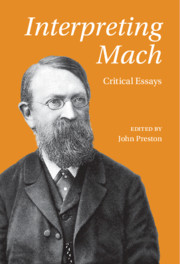Book contents
- Interpreting Mach
- Interpreting Mach
- Copyright page
- Dedication
- Contents
- Figures
- Tables
- Contributors
- Introduction
- 1 Ernst Mach’s Piano and the Making of a Psychophysical Imaginarium
- 2 Mother’s Milk and More
- 3 Meaningful Work
- 4 Mach on Analogy in Science
- 5 Ernst Mach’s Enlightenment Pragmatism
- 6 On the Philosophical and Scientific Relationship between Ernst Mach and William James
- 7 Ernst Mach and Friedrich Nietzsche
- 8 Abstraction, Pragmatism, and History in Mach’s Economy of Science
- 9 Holding the Hand of History
- 10 Ernst Mach and the Vienna Circle
- 11 Narratives Divided
- 12 Phenomenalism, or Neutral Monism, in Mach’s Analysis of Sensations?
- 13 The Case for Mach’s Neutral Monism
- Index
- References
10 - Ernst Mach and the Vienna Circle
A Re-evaluation of the Reception and Influence of His Work
Published online by Cambridge University Press: 05 March 2021
- Interpreting Mach
- Interpreting Mach
- Copyright page
- Dedication
- Contents
- Figures
- Tables
- Contributors
- Introduction
- 1 Ernst Mach’s Piano and the Making of a Psychophysical Imaginarium
- 2 Mother’s Milk and More
- 3 Meaningful Work
- 4 Mach on Analogy in Science
- 5 Ernst Mach’s Enlightenment Pragmatism
- 6 On the Philosophical and Scientific Relationship between Ernst Mach and William James
- 7 Ernst Mach and Friedrich Nietzsche
- 8 Abstraction, Pragmatism, and History in Mach’s Economy of Science
- 9 Holding the Hand of History
- 10 Ernst Mach and the Vienna Circle
- 11 Narratives Divided
- 12 Phenomenalism, or Neutral Monism, in Mach’s Analysis of Sensations?
- 13 The Case for Mach’s Neutral Monism
- Index
- References
Summary
There is a familiar narrative of the development from Ernst Mach’s 'positivism' to the more sophisticated 'neo-positivism' of the Vienna Circle, with language analysis and formal logic as additional ingredients. But we also see an alternative historiography telling of the rise and decline of scientific philosophy and the genetic theory of learning from Mach to the Vienna Circle. Recent research on Mach uncovers a more complex and multifaceted influence and pluralist reception of his work within the Vienna Circle based on a general appreciation of his empiricism and his idea of the unity of science. This chapter reconstructs the complex and diverse reception of Mach by main members of the Vienna Circle, showing the inherent pluralism based on the common anti-Kantian and 'late Enlightenment' consensus between empiricism and pragmatism, with Mach figuring as a critic of 'school philosophy' and a pioneer of contemporary history and philosophy of science. The thesis of a strong positive reception and further development and extension (regarding language and logic) of Mach’s doctrines with a critical distance vis-à-vis academic metaphysical philosophy is demonstrated as a manifestation of Mach’s function as a role model and predecessor of Viennese Logical Empiricism from the 'First Vienna Circle' to the heyday of the Schlick Circle.
- Type
- Chapter
- Information
- Interpreting MachCritical Essays, pp. 184 - 207Publisher: Cambridge University PressPrint publication year: 2021
References
- 2
- Cited by

